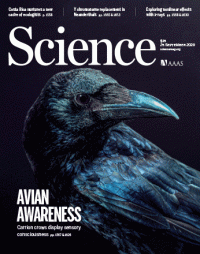
REPORT
A neural correlate of sensory consciousness in a corvid bird
Science 25 Sep 2020:
Vol. 369, Issue 6511, pp. 1626-1629
DOI: 10.1126/science.abb1447
Consciousness shared
Humans have tended to believe that we are the only species to possess certain traits, behaviors, or abilities, especially with regard to cognition. Occasionally, we extend such traits to primates or other mammals—species with which we share fundamental brain similarities. Over time, more and more of these supposed pillars of human exceptionalism have fallen. Nieder et al. now argue that the relationship between consciousness and a standard cerebral cortex is another fallen pillar (see the Perspective by Herculano-Houzel). Specifically, carrion crows show a neuronal response in the palliative end brain during the performance of a task that correlates with their perception of a stimulus. Such activity might be a broad marker for consciousness.
Science, this issue p. 1626; see also p. 1567
Abstract
Subjective experiences that can be consciously accessed and reported are associated with the cerebral cortex. Whether sensory consciousness can also arise from differently organized brains that lack a layered cerebral cortex, such as the bird brain, remains unknown. We show that single-neuron responses in the pallial endbrain of crows performing a visual detection task correlate with the birds’ perception about stimulus presence or absence and argue that this is an empirical marker of avian consciousness. Neuronal activity follows a temporal two-stage process in which the first activity component mainly reflects physical stimulus intensity, whereas the later component predicts the crows’ perceptual reports. These results suggest that the neural foundations that allow sensory consciousness arose either before the emergence of mammals or independently in at least the avian lineage and do not necessarily require a cerebral cortex.

No comments:
Post a Comment